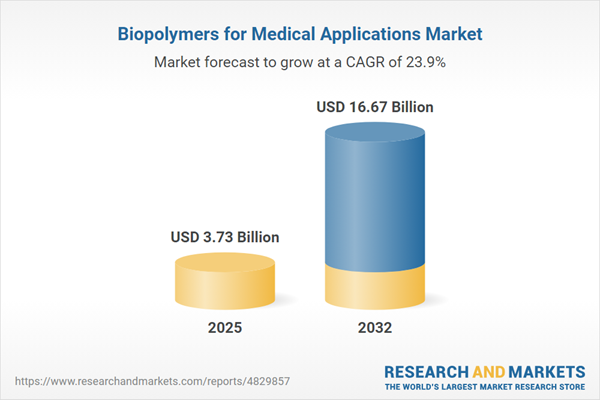Speak directly to the analyst to clarify any post sales queries you may have.
Senior healthcare decision-makers are accelerating the adoption of biopolymers for medical applications to address sustainability imperatives and ongoing regulatory shifts. This strategic focus enables organizations to enhance patient outcomes, align with evolving procurement standards, and position themselves as leaders in next-generation healthcare solutions.
Market Snapshot: Biopolymers for Medical Applications
The global biopolymers for medical applications market is valued at USD 3.00 billion in 2024, with an outlook projecting growth to USD 3.73 billion in 2025 at a CAGR of 23.89%. Current growth patterns reflect increased demand for biocompatible and sustainable materials—a trend shaped by the drive to improve device functionality, cost efficiency, and regulatory preparedness. Organizational leaders are focused on transparent, adaptable supply networks to navigate compliance requirements and market entry challenges, while fostering innovation for advanced medical devices and care solutions in a rapidly changing environment.
Scope & Segmentation of the Biopolymers for Medical Applications Market
A well-defined segmentation approach helps stakeholders identify targeted investment priorities and streamline operational strategies for the biopolymers for medical applications market across varying regional, technological, and regulatory contexts. The following categories are key to strategic decision-making:
- Biopolymer Types: Alginate, chitosan, collagen, hyaluronic acid, polyhydroxyalkanoates, and polylactic acid deliver unique biocompatibility profiles. Selection is guided by patient safety and compliance needs in areas like engineered tissues, implants, and wound management.
- Form Factors: Fibers, films, and hydrogels allow flexibility in integrating biopolymers into both clinical and diagnostic products where strong regulatory demands are present.
- Production Methods: Chemical synthesis, extraction, and fermentation underpin scalable, cost-effective, and environmentally sustainable manufacturing, meeting rigorous safety and quality benchmarks.
- Medical Applications: Utilization spans cardiovascular, dental, drug delivery, ophthalmic, orthopedic, surgical, and wound care. Advanced formats such as microspheres and nanoparticles introduce new routes for targeted therapies and specialty medical uses.
- End User Segments: Hospitals, clinics, pharmaceutical manufacturers, contract research organizations, and laboratories leverage biopolymers differently, prioritizing unique procurement and compliance strategies.
- Geographical Markets: Regional differences across the Americas, Europe, Middle East & Africa, and Asia-Pacific influence procurement, compliance, and adoption dynamics, requiring careful planning for strategic market entry and operational alignment.
- Corporate Strategies: Investment in R&D, proactive approaches to compliance, and cultivated innovation pipelines help organizations stay resilient, anticipate healthcare trends, and support continuous competitive advantage.
This segmentation framework empowers leaders to select optimal entry points, manage risk at the geographic and sector level, and develop partnerships that support evolving regulatory requirements in diverse global healthcare markets.
Key Takeaways for Senior Decision-Makers
- Forming partnerships between manufacturers, healthcare providers, and research organizations accelerates pipeline development and supports robust compliance for biopolymer-based devices.
- Fostering supply chain transparency increases confidence among stakeholders and bolsters reliability in medical device delivery, ensuring consistent operational performance.
- Adopting advanced technologies, including electrospinning and additive manufacturing, enables custom biopolymer-based implants and scaffolds, directly addressing complex and emerging clinical needs.
- Engaging in joint ventures with pharmaceutical and research companies streamlines market entry and expedites clinical validation for novel applications, reducing time-to-market.
- Building adaptive supplier relationships and workflow agility provides resilience against regulatory and market fluctuations, maintaining continuity in material access and compliance.
- Maintaining an active dialogue with regulatory agencies keeps strategic planning current, reduces compliance risk, and promotes alignment with changing international standards.
Tariff Impact: United States Policy Shifts
Recent U.S. tariff changes have raised costs associated with importing biopolymer raw materials. To navigate this environment, organizations are increasing investments in domestic production capacity and diversifying their sourcing strategies. Risk management and flexible supply chains are now central to mitigating uncertainty driven by regulatory and trade developments.
Methodology & Data Sources
The findings in this report result from a triangulated approach involving insights from senior executive interviews, structured stakeholder surveys, and extensively validated regulatory and scientific data. This method helps deliver precisely targeted intelligence for compliance and strategic planning in the biopolymers for medical applications market.
Why This Report Matters: Biopolymers for Medical Applications
- Supports executive-level planning by providing strategic insight into procurement transformation and the evolving dynamics of healthcare compliance.
- Offers segmented, actionable guidance for investment and risk mitigation tailored to global and regional operational realities.
- Aligns organizational strategy with sustainability initiatives and future-focused technology adoption to ensure ongoing competitive advantage.
Conclusion
Organizations focusing on supply chain transparency, sector collaboration, and proactive planning are best equipped to sustain value and growth within the expanding biopolymers for medical applications sector.
Additional Product Information:
- Purchase of this report includes 1 year online access with quarterly updates.
- This report can be updated on request. Please contact our Customer Experience team using the Ask a Question widget on our website.
Table of Contents
3. Executive Summary
4. Market Overview
7. Cumulative Impact of Artificial Intelligence 2025
Companies Mentioned
The companies profiled in this Biopolymers for Medical Applications market report include:- Evonik Industries AG
- Corbion N.V.
- NatureWorks LLC
- DuPont de Nemours, Inc.
- Koninklijke DSM N.V.
- Tepha, Inc.
- Sigma-Aldrich Corporation
- Danimer Scientific, Inc.
- BASF SE
- Braskem S.A.
Table Information
| Report Attribute | Details |
|---|---|
| No. of Pages | 192 |
| Published | November 2025 |
| Forecast Period | 2025 - 2032 |
| Estimated Market Value ( USD | $ 3.73 Billion |
| Forecasted Market Value ( USD | $ 16.67 Billion |
| Compound Annual Growth Rate | 23.8% |
| Regions Covered | Global |
| No. of Companies Mentioned | 11 |









